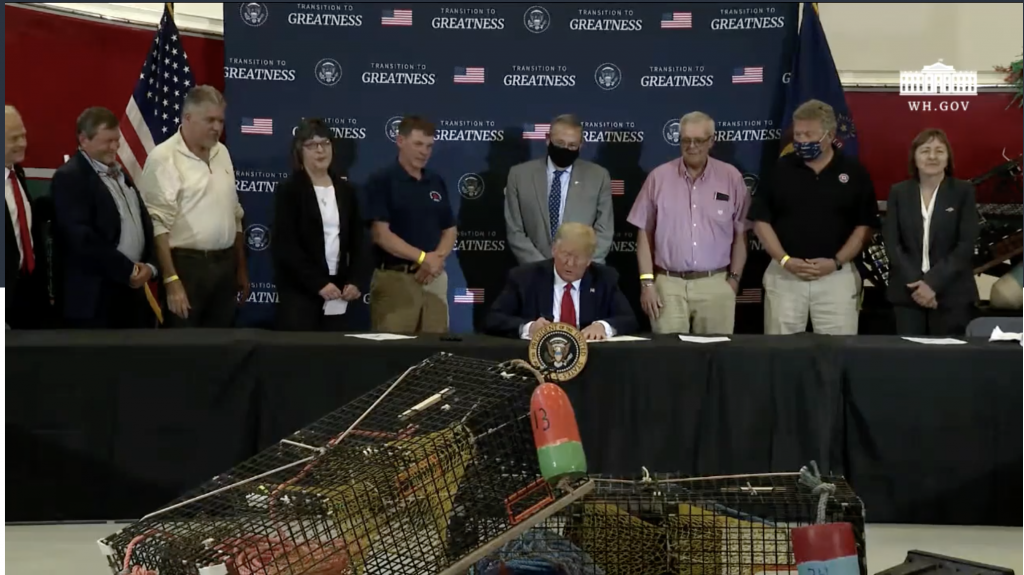June 5, 2020 — WASHINGTON — Members of Saving Seafood’s National Coalition for Fishing Communities thank President Trump for the presidential proclamation signed today restoring sustainable commercial fishing activities in the Northeast Canyons and Seamounts Marine National Monument. Our members are grateful to elected officials from both parties, White House staff, and fisheries managers who have pushed for our fisheries to be managed under the Magnuson-Stevens Act, and who have advocated for commercial fishermen to be fully included in the regulatory processes that shape their livelihoods.
Under the proclamation, a revision to President Barack Obama’s executive order designating the Northeast Canyons and Seamounts Monument, the contours of the monument remain unchanged, and potentially destructive oil drilling and exploration remains banned. But commercial fishermen are now allowed to resume fishing in waters they had fished for decades before the monument was created, in areas that President Obama and others called “pristine” even before commercial fishermen were banned from them. It also restores parity with recreational fishermen, who were never prohibited from fishing in the monument area.
Our members believe in robust debate among industry, scientists, regulators and environmentalists to produce the best decisions regarding fisheries management. While it is not perfect, the Magnuson-Stevens Act, the primary law governing U.S. federal fisheries, has been championed by both industry and environmental advocates for helping to make U.S. fisheries a sustainable model for the world. Today’s revision restores management of fisheries within the monument area to the regional management councils created under the Magnuson-Stevens Act, once again allowing for the robust debate such impactful policy decisions demand.
In April 2010, President Obama signed a Presidential Memorandum establishing the “America’s Great Outdoors Initiative” to “promote and support innovative community-level efforts to conserve outdoor spaces and to reconnect Americans to the outdoors.” In the ensuing report the administration pledged to implement “a transparent and open approach to new national monument designations tailored to engaging local, state, and national interests.” Unfortunately, the Obama Administration did not uphold President Obama’s pledge in the creation of the Atlantic marine monument, or in the expansion of Pacific marine monuments.
In a 2017 letter to President Trump asking him to restore fishing in marine national monuments, then-Chairman of the House Committee on Natural Resources Representative Rob Bishop (R-UT) and Representative Aumua Amata Coleman Radewagen (R-AS) wrote, “Removal of the fishing prohibitions in the monument proclamations and the return of U.S. fisheries management to the Regional Fishery Management Councils would continue to prevent overfishing and protect the marine environment as required by the MSA and other applicable laws, while allowing our fishing fleet to compete with their foreign competitors. Using the Antiquities Act to close U.S. waters to domestic fisheries is a clear example of federal overreach and regulatory duplication and obstructs well managed, sustainable U.S. fishing industries in favor of their foreign counterparts.”
The nation’s eight regional councils have also repeatedly pushed for management of fishing in marine national monuments to be returned to the council process. Just last week in a letter to Secretary of Commerce Wilbur Ross, they wrote, “The ban on commercial fishing within Marine National Monument waters is a regulatory burden on domestic fisheries, requiring many of the affected American fishermen to travel outside U.S. waters with increased operational expenses and higher safety-at-sea risks.” They further stated, “marine National Monument designations in their present form hinder the Councils’ ability to sustainably manage fisheries throughout their range, and they restrict the Councils and the National Marine Fisheries Service from acquiring invaluable knowledge about the stocks and the marine ecosystem made available through catch-and-effort and observer data.”
Mayor Jon Mitchell of New Bedford, Massachusetts, the nation’s top fishing port by value, a Democrat, expressed deep concern about the lack of broad stakeholder consensus in the monument designation, and expressed his preference for the council process. In testimony before Congress in 2017, he said, “The monument designation process has evolved effectively into a parallel, much less robust fishery management apparatus that has been conducted entirely independent of the tried and true fishery management council process. It lacks sufficient amounts of all the ingredients that good policy-making requires: Scientific rigor, direct industry input, transparency, and a deliberate pace that allows adequate time and space for review.”
The council process has led to many conservation successes, such as efforts to preserve coral habitats in the Mid-Atlantic. Most importantly, these conservation successes were achieved through robust debate among all stakeholders. Saving Seafood Coalition members are pleased that today’s proclamation will allow this robust debate to once again guide fisheries management in the Northeast Canyons and Seamounts Monument.
Coalition members also continue to believe that there is no difference in principle between the Northeast Canyons and Seamounts Monument and other U.S. marine national monuments in the Pacific, and that the council process is the appropriate method for managing fisheries in all U.S. federal waters. The U.S. has the largest exclusive economic zone (EEZ) in the world, and the U.S. Pacific is the largest part of the U.S. EEZ, with our Pacific fishermen working hard to provide economic vitality to their communities, and food security to our nation.
Our members look forward to working with the White House to restore the proper regulation of commercial fishing under the Magnuson-Stevens Act in the Papahānaumokuākea Marine National Monument, the Pacific Remote Islands Marine National Monument, the Marianas Trench Marine National Monument, and the Rose Atoll Marine National Monument.

